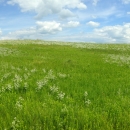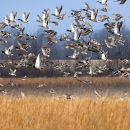What We Do
Wildlife conservation is at the heart of the National Wildlife Refuge System. It drives everything on U.S. Fish and Wildlife Service lands and waters managed within the Refuge System, from the purposes for which a unit is established to the recreational activities offered to the resource management tools used. Using conservation best practices, the Refuge System manages lands and waters to help ensure the survival of native wildlife species.
Our management goals are to acquire and protect quality habitat suitable for nesting migratory birds, local wildlife, and native plant species. The Wetland Management District staff perform a variety of management techniques to enhance wildlife and plant communities.
Management and Conservation
Prescribed Burning:
Prescribed burning is primarily used to stop the spread of woody vegetation that has increased over the years due to fire suppression. Prescribed burning also helps control the spread of non-native plant species. These controlled burns help wildlife and their habitat by stimulating prairie plant growth and increasing soil nutrients.
Livestock Grazing Systems:
A livestock rotational grazing system replicates the historic effects of bison. This intensive, short duration system is directed primarily at reducing the exotic cool season, sod-forming grasses (e.g. smooth bromegrass and Kentucky bluegrass) while increasing the vigor of native grasses.
As bison herds diminished, the composition of grassland plants and animal species began to change dramatically. Cattle have since replaced bison and they stimulate native grasses. Over time, livestock grazing is slowly restoring and sustaining native prairie grassland species and the unique mix of animals that rely on this habitat.
Noxious Weed Control:
The spread of noxious weeds has been difficult and expensive for Wetland Management District managers. Leafy spurge is perhaps the most difficult of all exotic plants to control in the Wetland Management District. Some of the noxious weeds require treatment beyond fire and grazing. Current management techniques include introducing biological controls such as spurge-eating flea beetles, limited herbicide application, and mowing areas to prior to the plants producing seeds.
Our Services
At this field station we offer the following public services:
- A small contact station with local hunting and wildlife viewing information.
- Educational and wayfinding brochures, including a map of the Waterfowl Production Areas.
- Administration of cooperative agriculture programs.
- Issuance of Special Use Permits.
- Project reviews related to energy development when U.S. Fish and Wildlife Service interests are involved.
Laws and Regulations
U.S. Fish and Wildlife Service follows Federal laws, policies, and treaties passed throughout history. Click on the "Laws and Regulations" tab under "What We Do" to learn about important acts that pertain to the Lostwood Wetland Management District.

